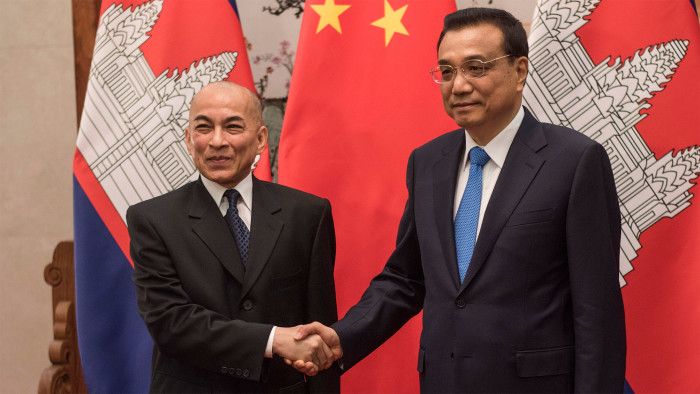China draws Cambodia closer in diplomatic embrace

Simply sign up to the Chinese politics & policy myFT Digest -- delivered directly to your inbox.
China is quietly drawing Cambodia into an ever closer military and diplomatic embrace, as part of its effort to quell regional opposition to its sea territory claims across Asia.
As Southeast Asian states prepare for a crucial regional summit next week in Laos, Phnom Penh has emerged as Beijing’s staunchest local ally — both politically and through strategic projects such as a deepwater port on Cambodia’s coast that is now close to completion.
The deepening of China’s historical ties with the government of Hun Sen, Cambodia’s autocratic prime minister of 31 years, are likely to raise concerns both in Washington and among the 10-member Association of Southeast Asian Nations (Asean) at their Laos meeting.
The summit, which US President Barack Obama is also due to attend, follows an international tribunal ruling in July that censured Beijing’s building of artificial islands in the South China Sea and ruled that there was no historical basis for its claim to 85 per cent of the area’s waters.
Beijing has paid “very special attention” to Cambodia because of its positions in both Asean and in the Mekong region that borders the South China Sea, said Chheang Vannarith, chairman of the Cambodian Institute for Strategic Studies, a think-tank.
“The Mekong region is the most important backyard for China’s strategic calculations,” Mr Chheang Vannarith said. “For China to increase its influence, it needs to increase its power there.”
The new Cambodian port, which will be an important extra element in China’s push to become the predominant maritime power in Asia, is part of a $3.8bn project on a 90km stretch of coastline.

The project is being built by the Tianjin Union Development Group (UDG), a Chinese company working with the support of the People’s Liberation Army and operating under a 99-year-lease from Phnom Penh, according to company executives and documents. The land concession is unusually large and cedes control of more than 20 per cent of Cambodia’s total coastline.
The project has received high-level political and military backing in Beijing. The signing ceremony for UDG’s investment was presided over by Zhang Gaoli, a member of China’s politburo, according to documents obtained by the Financial Times.
The port on the Gulf of Thailand coast liesjust a few hundred kilometres from disputed territories in the South China Sea. It is deep enough to handle cruise ships, bulk carriers or naval vessels of up to 10,000 tonnes in weight, according to company executives.
The facility could accommodate most of the frigates and destroyers in the Chinese navy, said Geoff Wade, an expert on Asia at the Australian National University. He added that it was part of a network of Chinese port investments in Asia, notably in Sri Lanka, Pakistan, Myanmar, Bangladesh, Thailand and Indonesia.
“Ports are extremely important in this pursuit of regional domination,” Mr Wade said.
China denounced the July verdict of the international tribunal, which was the result of a case brought by the Philippines. The outcome has stoked regional tensions and has potential repercussions for other Asean countries entangled in sea rights disputes with China, including Vietnam, Malaysia and Brunei.
China has underscored an increasing split in Asean, praising Phnom Penh in July for heading off direct public criticism of Beijing at a meeting of the group’s foreign ministers.
Other signs that China’s longstanding links with Cambodia are growing stronger include a bilateral military aid agreement struck with much fanfare last November. Tea Banh, Cambodia’s defence minister, said after the signing that Beijing had provided shoulder-fired anti-aircraft missiles and that Phnom Penh was also seeking longer-range armaments capable of taking out fast aircraft.
China also sold Cambodia 12 Harbin Z-9 helicopters in 2013, paid for with a near-$200m bilateral loan. Beijing has donated trucks and tens of thousands of military uniforms to the country, as well as putting money behind infrastructure. Chinese flags fly at a large military hospital near the Wat Phnom temple in the Cambodian capital, while the sides of vehicles parked there declare that they were bought with Chinese assistance.
China also supplies small arms and trainers to a new military academy, said General Chhum Socheat, a Cambodian defence ministry spokesman, who added that he had visited Beijing last year. He estimated that more than 100 Cambodian armed force members went to China each year for training, although he insisted that Phnom Penh remained “neutral” and “open to all countries”.
US military aid to Cambodia is small by comparison and has been held in check by political tensions. Cambodia announced it was suspending some military co-operation with Washington in 2013, after US congressmen criticised national elections that the opposition said were rigged.
Comments